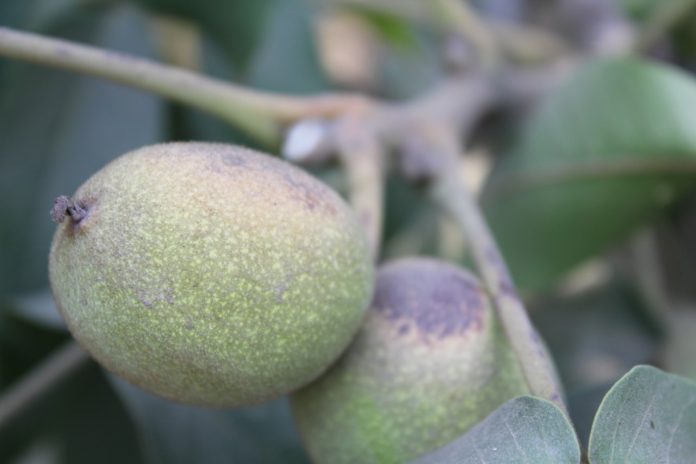
UC Davis Plant Pathologist Themis Michailides reported recent research findings on walnut mold and management at the 2021 Crop Consultant Conference.
The main pathogens of walnut mold are Alternaria, Fusarium species and Aspergillus niger. Botryosphaeria and/or Phomopsis canker and the bacterial disease walnut blight are also cause for mold in orchards.
” width=”300″ height=”260″ />
Brown Apical Necrosis is a special type of walnut mold that always starts from the stylar end of the nut and is sometimes associated with the bacterial disease walnut blight. Michailides confirmed that there is a strong correlation of fungi causing walnut mold with the same fungi attacking and decaying the hulls. The incidence of mold starting from the stylar end was significantly greater than that of mold starting from the stem end, suggesting possible stylar infection at bloom. In trials over two years, sprays at two to three weeks before hull split and early hull split reduced walnut mold in both early and late walnut cultivars.

In the U.S. standards for grades of walnuts, mold is listed as damage when attached to the kernel or when white or gray mold affects a portion of the surface of the kernel. Potential for mold development in a walnut crop increases as harvest is delayed. Sunburnt nuts, windfalls on the ground for more than 15 days, nuts infested with navel orangeworm, nuts with large stem openings and larger nuts are also subject to mold development.
Michailides said levels of mold reported in recent years included a Chandler sample from Tulare County showing 21% mold, grade sheets from 2020 from Butte County areas near the Sacramento River with 10% to 16% mold and, in 2019, reports of 10% to 20% mold in Butte and Glenn counties.

In his presentation, Michailides noted that previous studies on walnut mold showed that mid-May to mid-July sprays reduced Botryosphaeria and Phomopsis canker and blight, but they did not reduce molds caused by Alternaria or Fusarium. He said the fact that fungi-causing mold are the same as those that colonize the hulls led the decision to move towards sprays before hull split and early hull split.
To reduce incidence of mold in walnuts, Michailides said applying Merivon at three weeks prior to hull split reduces mold related to Botryosphaeria, Phomopsis and Alternaria. Adding Tebuconizole to the tank mix will increase efficacy against Phomopsis. To further increase efficacy, apply Rhyme at 20% to 30% hull split. If the high level of control is not needed, Rhyme can be applied at 20% to 30% hull split.















